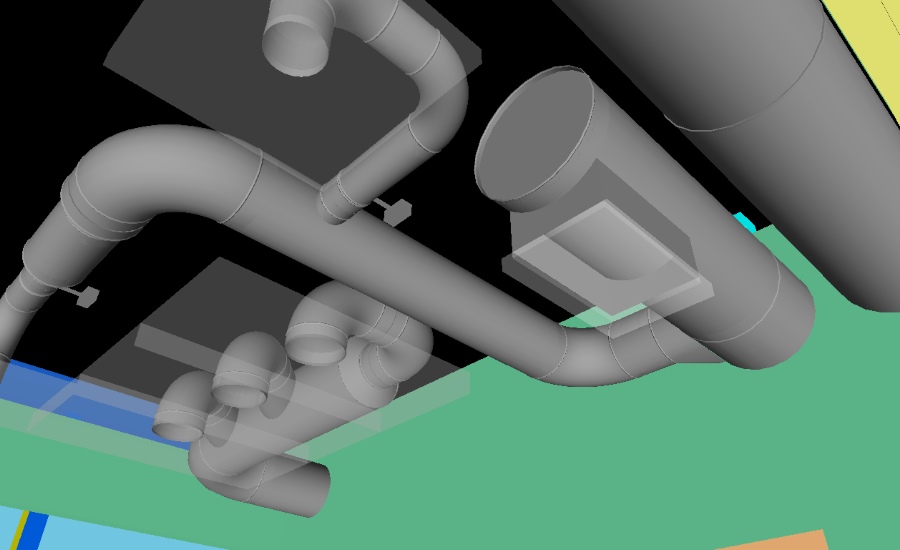Walsh Mechanical Contractors is recognized for its design-assist capabilities, cutting-edge BIM software, machine shop technology, transportation operations and efficiently coordinated field work. Its specialty is the ability to manufacture and install all types of quality ductwork, including the most environmentally responsible system of air distribution, spiral ductwork.
Because spiral duct, including flat oval, exhibits a very high level of air-tightness, Walsh Mechanical can guar-antee a line of spiral duct that meets or exceeds the highest air-leakage standard recognized by the Sheet Metal and Air-Conditioning Contractors’ National Association.

Additionally, Walsh Mechanical was among the first to receive the Underwriters Laboratories’ third-party certification for the listing and labeling of sheet metal air duct under the accrediting agency’s sheet metal air ducts category. This certification assures the fabrication of superior duct systems; it provides a higher degree of confidence to the engineering/architectural community, via an independent third-party, that duct is constructed to the industry standard; it provides a continuing education process for participating firms; ensures that an efficient, low-leakage air distribution system is constructed; and provides a means for identifying sheet metal duct that is compliant with code.
The challenge
In 2010, Walsh Mechanical was hired as the mechanical contractor for the Shire Human Genetic Therapies build-ing expansion in Lexington, Mass. The Lexington Technology Park Building No. 200 project was designed with office and laboratory elements to meet the program needs of a research and development building.
The building is a three-story, 190,000-square-foot facility housing clinical and commercial manufacturing, warehousing, central utilities and administrative offices. The building is organized into two wings: a north wing that includes the office functions (approximately 60,000 square feet) and a south wing that includes the laboratory functions (about 111,200 square-feet) with a lower level accommodating building support space.
The project goal was to achieve a Leadership in Energy and Environmental Design-silver rating from the U.S. Green Building Council and the building was designed to extend and complement the existing site buildings both functionally, including energy savings, and aesthetically by enhancing the occupants’ work place environment with indoor air quality and noise reduction.
To reduce waste in the design and construction process and eliminate unnecessary effort, the entire project team — from architect to fabrication — used virtual construction coordination using a sophisticated set of BIM tools and integrated project delivery. A fully coordinated virtual model was developed in October 2010, releasing fabrication grade drawings and accurate quantity takeoffs for pre-fabrication and bulk procurement. The model rep-resented a shared effort between the owner, architectural and engineering disciplines, trade partners and construc-tion teams. Walsh contributed with six full-time CAD personnel contributing over 4,000 CAD man-hours.
Walsh provided the full mechanical services with their in-house piping and sheet metal capabilities. Their model-based prototyping process, enabled by manufacturing BIM software from Technical Sales International, streamlines and improves the quality of their internal shop drawings and fabrication production. TSI’s managed content libraries allow Walsh Mechanical to draw to fabrication-level detail from the start of the design phase and then, using the same manufacturing BIM software, send the ductwork layouts of a model directly to the shop machines for flawless fabrication of the spiral duct components.
Additionally, their online coordination capabilities — being able to respond to and implement jobsite changes quickly and accurately — was a huge success made possible by TSI’s integration of 3-D modeling software with on-site Trimble units.
“Using manufacturing BIM software from TSI allowed us to almost totally eliminate waste on all systems using the spiral duct,” said Tom Downey, BIM manager at Walsh Mechanical. “This is because having an accurate model allows us to fabrica te all spiral duct to the exact lengths required, rather than standard lengths to be measured and cut in the field.”
Spiral takes the ‘LEED’
Because the entire mechanical system was evaluated on energy savings, air quality and noise emissions, all of which contributes to the LEED rating, spiral ductwork was chosen for its inherent qualities: airtightness, energy savings, comfort, sound attenuation, lower space requirements, quicker installation, delivery and storage, and certifiable guaranteed performance.
As a SPIDA member, Walsh Mechanical led the design assist team in implementing spiral duct design into the project in order to take advantage of the benefits. Once the building envelope was optimized, the infrastructure was integrated to fulfill the space’s programmatic requirements, including active chilled beams, heat-shift chillers, high-efficiency chillers and cooling towers, daylight harvesting, as well as low-pressure air-handling and distribution designs. For instance, chilled beams were used as the basis of design for delivering conditioned air to the lab and office spaces. Walsh Mechanical installed 869 chilled beams with more 13,000 linear feet of spiral duct, all fabricated in their Abington, Mass., facility. Walsh was able to consistently pass SMACNA Leakage Class 3 requirements using this spiral duct design.

Walsh Mechanical was able to fabricate the spiral duct in their facility, pre-build or “manifold” it into manageable sections, and then put these sections in rolling containers for shipment to the site.
Duct and piping risers were also fabricated in shop, and shipped to the job on flatbed tractor trailers and installed with cranes, reducing field time and exposure to hazardous work conditions around open shafts. Fabricated materials were only allowed on sight three days prior to installation, alleviating jobsite congestion and enhancing job safety. At the height of construction Walsh Mechanical had 61 workers on site and 14 more in their fabrication facilities dedicated to the project and contributed over 60,000 man-hours without a single injury.
Software help
Further enabling compliance with jobsite restrictions, Walsh Mechanical used TSI’s Job-Site Solutions software and two Trimble Total Station units to install thousands of duct and piping hangers prior to any duct or pipe landing on site.
“We had used the TSI Job-Site Solutions software and Trimble hardware for our hanger layout on building B400 with such great success that the construction manager had suggested that other (subcontractors) invest in the product to help ensure exact placement of each trade’s work due to the tight conditions,” said Walsh project manager Bill Kimball.
The mechanical work in over 190,000 square feet of usable space with 80,000 square feet of lab space was completed in just 12 months. Walsh’s design assist role and 3-D virtual modeling with TSI’s manufacturing BIM software contributed to enhanced planning that allowed for these “on time” deliveries of pre-fabricated spiral duct, pipe and equipment.
With the use of spiral duct, the project saved energy, improved indoor air quality with more even airflow and increased fresh air intake — made possible by the airtight ducts — and the entire HVAC system generates less noise because of the equalized pressure in spiral ductwork.
Although spiral duct comes in standardized sizes, Walsh Mechanical was able to cut to the lengths required with its manufacturing BIM software from TSI. Finally, installation was quicker because longer lengths of spiral duct can be produced and it is more easily transported and stored because of its lighter weight and its ability to nest together in various sizes.
Walsh Mechanical Contractors’ experience, innova-tion and sophisticated facilities, combined with the fea-tures and benefits of spiral ductwork, and design-to-fab-rication BIM software and Job-Site Solutions provided by Technical Sales International, all successfully contributed to the project’s LEED rating.
“The combination of our BIM software capabilities, use of the Trimble, and in-house production of our own spiral pipe made for a winning combination,” Kimball said. “Our investment in this cutting edge technology has allowed us to become one of the most competitive mechanical contractors in our area.”
This article originally appeared in the January 2012 issue of SNIPS magazine. Words and images were supplied by Technical Sales International and Walsh Mechanical Contractors.









